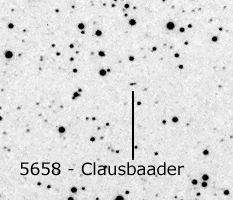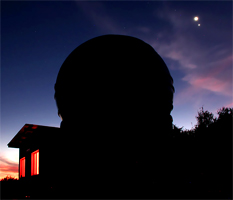 |
For this year's longer stay in Namibia we planned to photograph the
minor planet (5658) Clausbaader. It had a high altitude in the evening sky,
close to Saturn. The series is intended as a small tribute to Mr. Claus Baader,
the founder of Baader Planetarium in Mammendorf, who was one of the leading
personalities in the field of amateur astronomy and public education in the
last century in Germany.
Read official IAU text naming
Clausbaader
« The 4m dome on Onjala with the conjunction of Venus
and Jupiter on July 2, 2015. Alle images on this website can be enlarged by
clicking on it and open in a separate browser window. |
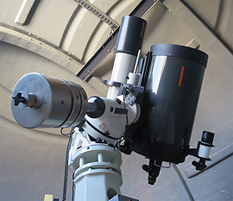 |
« The imaging instrument - the 150mm Zeiss APQ refractor and a
Celestron C14 on a Astrophysics 1200 GTO mount in the 4 meter dome.
The
images were captured at the 150mm Zeiss APQ refractor at Onjala Observatory and
an "ancient" SBIG ST2000-XM.
|
| After completion of our
"Project Pluto" - the experiment to take Pluto with a
classic 2 inch telescope - first test images were made on September 5. The
whole project was ill-fated from the very start. |
|
| |
» First Paech dropped his
glasses and broke it exact in the center. The spare pair worked quite well in
daylight however in the dark night the stars remained blurry. Luckily there was
a "magical" two-component glue who managed to connect the broken glasses
permanentely.
» » In
addition, the drying cartridge of the for years unused SBIG ST-2000 XM CCD
camera stopped working. Even at temperatures just above 0 degrees the chip
surface iced up despite the low humidity of about 20 percent. Test shot from
September 5 with a completely iced chip surface. |
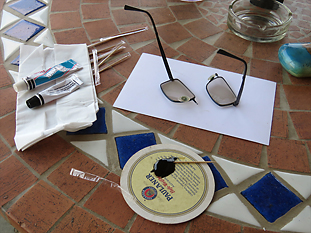 |
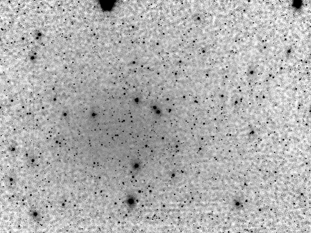 |
|
|
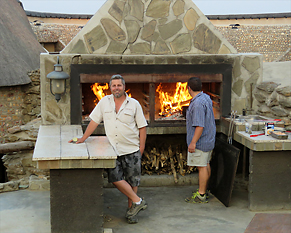 |
 |
Since the kitchen of Onjala Lodge has only gas ovens without
temperature display and microwave ovens there was the question: how to "bake"
the cartridge.
According to the
SBIG the cartridges must not be dried in a microwave oven so we decided to use
the "hellfire" of regular Saturday BBQ evening and "grill" the cartridge for a
few hours. |
| The success was not stunning but enough to operate the camera within
the next two nights at temperatures around 0 degrees celsius. |
|
To be sure that the positioning of the GTO1200 mount points to the
correct small field of view, the mount was initially positioned on Saturn, then
performed a recalibrate of the controller and then positioned on the
coordinates of Clausbaader. To finally check the positioning the corresponding
field has been verified with the star map program GUIDE 9.0.
This
comparison between GUIDE and the live image of the SBIG camera is not so easy,
as the camera shows even at short exposure times far more stars than the sky
map shows. In addition, the orientation of the star map must match with the camera
image. Unfortunately there were no conspicuous star constellations at the
position of Clausbaader which made this step more complicated.
» The right image shows the position of
Clausbaader on September 09, 2015. In the image field there were also the minor
planet Wurm (1785) and some other objects. But they were so faint that they are
not detectable with this image equipment.
The large rectangular frame
on the star map shows the image field of the ST-2000 XM, the minor rectangle
shows the field of the guiding chip. |
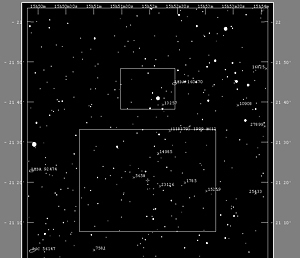 |
|
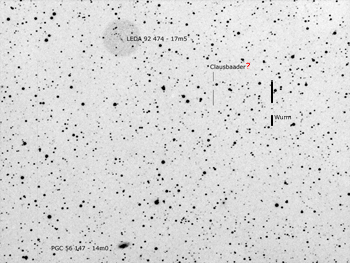 |
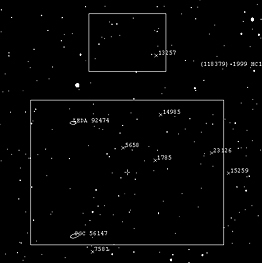 |
The first attempt to photograph Clausbaader took place on the evening
against 19:34 UTC with a 300 seconds exposure. A second image should be taken 2
hours later to identify the minor planet by its movement against the background
stars. Unfortunately, the sky clouded at this time. In general, the weather
during our stay in Namibia from early July to the end of September was very
mixed.
« A first analysis of the
image confirmed the correct image field (field size: 33.9 x 25.4 arcmin, scale
1.27 "/ pixel), the position of the two galaxies LEDA 92474 and PGC 56147 agree
with the map from GUIDE.
|
|
The minor planet Wurm clearly shows a short line because of its higher proper motion (image left above).
At the point
where GUIDE shows the position of Clausbaader, a faint object is in the image
but it could also be a background star. Therefore, the object in the image is
marked with a question mark.
|
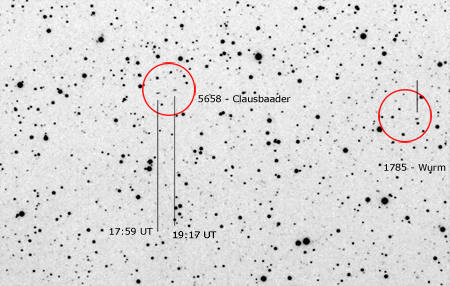 |
On the next evening three images, showing the minor planets Clausbader
and Wurm and their movement in the sky, could be taken. The brightness of
Clausbaader with 18.5 mag was already at the limit for camera and telescope for
a moving object.
« The left
image shows a superposition of two 600 second exposures. The positions of Claus
Baader and Wurm are marked (17:59 and 19:17 UTC). Between these two images, a
continuous 2400 seconds exposure was captured (see below). The waiting time was
pleasantly spent with a GinTonic in the bar of Onjala Lodge. Now, the other
image data:
| Minor
planet |
Proper
motion |
angle
(degrees) |
brightness
(mag.) |
| Wurm |
59.1"/h |
98.6 |
17.9 |
| Clausbaader |
41.8"/h |
99.4 |
18.5 |
The minor planet Clausbaader was at the time of shooting at a
distance of 2,971 AE or 444,447,000 km from the center of the
Earth. |
|
» Animation of (5658)
Clausbaader from 09.09.2015 (17:59 and 19:16 UTC).
Click here to load a larger image
» » Clausbaader and Wurm in a 2400
second exposure (09.09.2015 - 18:15 to 18:55 UTC). The stellar limiting
magnitude is around 21 mag.
Click here to load a large animation of the proper motion
of Claus Baader and Wurm. |
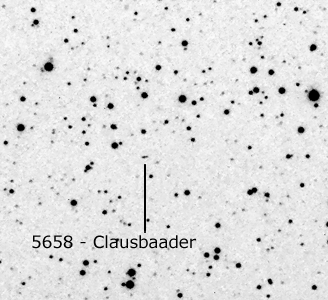 |
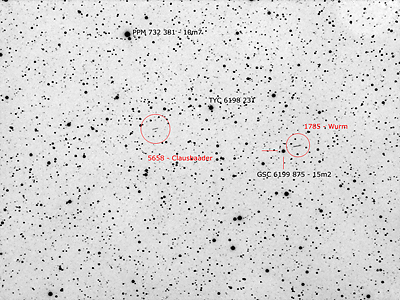 |
|
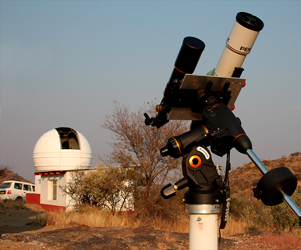 |
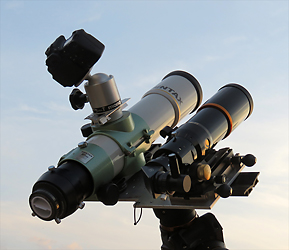 |
Due to the fact that the minor planet Clausbaader was located in a
very attractive part of the sky at this time, an overview image was also taken
(see image below).
For this purpose an original Canon EOS 60Da with a
50mm lens (1.8) was used. 6 single images with 640 ASA and 600 seconds exposure
time were taken. The lens was stopped down to f/4.5.
« « The picture shows the portable
mount, a Celestron CGEM DX. In the background the Onjala 4m dome and the
private 3m dome of Chameleon Observatory just before sunset. |
|
Image top
right: The EOS sat "piggyback" on a 105mm Pentax refractor (next to the
right a Celestron 80mm Onyx). The mount is performing so well that no guiding
was needed. Click on the image below right to load
a large version.
|
Following the official text for naming the minor planet number
5658 Clausbaader.
Named in memory of Claus
Baader (1924-1995), German manufacturer of planetaria, domes and telescopes,
and well-known mentor of amateur astronomers in the German-speaking countries.
A design engineer by profession and self-taught in astronomy, Baader
constructed a new type of a small desktop planetarium that is in use in schools
in many countries throughout the world. In his later years Baader, together
with his son and successor Thomas, was deeply concerned with the construction
and development of observatory domes, astronomical telescopes and their
auxiliary instrumentation for amateur and professional astronomers alike.
(From the Minor Planet Circular (MPC) 25977 from November 7,
1995) 1950 DO.
Discovered 1950 Feb. 17 by K. Reinmuth at Heidelberg.
Name proposed and citation prepared by L.D.Schmadel. |
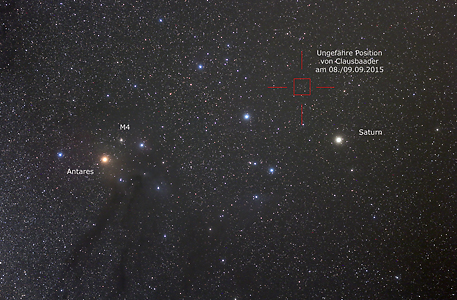 |
Claus Baader on the website of the Minor Planet
Center
DOWNLOAD Obituary of Claus Baader by G. D. Roth (only available in
german language) |
|
|
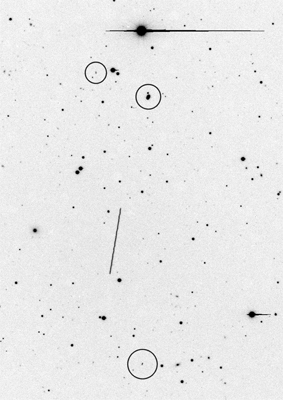 |
Karl Wurm (born July 21, 1899 in Siegen; † 16 February
1975 Bonn) was a German astronomer. Wurm studied at the University of Bonn
mathematics, physics and chemistry with a doctorate in 1926. Then he went to
the Astrophysical Observatory in Potsdam, where he studied band spectra of
molecules from stellar atmospheres and comets. This led to a contribution in
the Handbuch der Astrophysik (1930). He did research on comets and in
particular after a atudy stay at Yerkes Observatory (Otto von Struve) on
spectra of gaseous nebulae. In 1941 he was main observator of the Hamburg
Observatory in Hamburg-Bergedorf. In 1950 he was a few months visiting
professor at the Humboldt University in Berlin and at the observatory in
Babelsberg. Due to the poor observation conditions in Hamburg he observed since
1954 regularly in Asiago (Veneto). SOURCE:
Wikipedia
Karl Wilhelm Reinmuth
(born April 4, 1892 in Heidelberg, † May 6, 1979) was a German astronomer
who worked at the observatory on the Königstuhl near Heidelberg. Reinmuth
attended secondary school and then studied at the University of Heidelberg.
Even as a student, he worked at the observatory under Max Wolf in 1916. He
received his doctorate with a thesis of photographic positioning of 356
Schultz's nebulae. Until his retirement in 1957 he was employed at the
Königstuhl, only interrupted by military service in World War I. Since
1914 as an assistant, since 1926 as an observer and since 1937 as a
top-observer. In 1928 he married Lina, born Alstede. The couple had three sons.
Reinmuth discovered two short-period comets, namely 30P/Reinmuth and
44P/Reinmuth and 395 asteroids (see List of asteroids), including Apollo, the
namesake of a group of asteroids (Apollo-type), whose paths can cross the
Earth's orbit. Reinmuth's discoveries of asteroids was in the period from 1914 to
1957.
Particularly spectacular was his discovery of
the asteroid (69230) Hermes in 1937, which
was rediscovered in 2003 by the Lowell Observatory's Near-Earth-Object Search
program. Calculations of the orbit was done by the German astronomer Friedrich
Gondolatsch. SOURCE: Wikipedia |
|
| Image top left: The minor planet (69230) Hermes - CCD
recording from W.Paech, shortly after its rediscovery on October 28, 2003.
Exposure time 1800 seconds with a SBIG ST-10 XME. The image shows three more
minor planets in the circles. Raw image was taken in Germany, near Hannover,
Lower Saxony |









